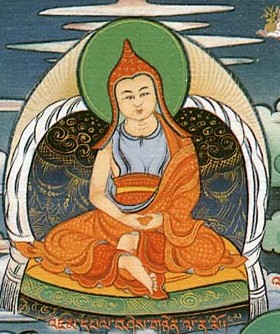Three categories: Difference between revisions
Jump to navigation
Jump to search
(Tibetan.) |
|||
| Line 1: | Line 1: | ||
[[Image:Manjushrimitra.jpg|frame|[[Mañjushrimitra]]]] | [[Image:Manjushrimitra.jpg|frame|[[Mañjushrimitra]]]] | ||
'''Three categories''' or '''three classes''' (Tib. ''dé sum''; | '''Three categories''' or '''three classes''' (Tib. སྡེ་གསུམ་, ''dé sum''; Wyl. ''sde gsum'') — the three categories into which [[Mañjushrimitra]] divided the [[Dzogchen]] teachings he received from [[Garab Dorje]]: | ||
#the [[outer category of mind]] (''semdé''), | #the [[outer category of mind]] (''semdé''), | ||
Revision as of 19:47, 3 February 2017

Three categories or three classes (Tib. སྡེ་གསུམ་, dé sum; Wyl. sde gsum) — the three categories into which Mañjushrimitra divided the Dzogchen teachings he received from Garab Dorje:
- the outer category of mind (semdé),
- the inner category of space (longdé), and
- the category of pith instructions (mengak dé).
Alternative Translations
- Three sections
Oral Teachings Given to the Rigpa Sangha
- Sogyal Rinpoche, Paris, 26-27 June 1982, the 'Seven Stages of the Categories of Mind: Semdé, Longdé and Mengakdé'.
- Sogyal Rinpoche, Les Ages retreat, France, 16 August 1987
Further Reading
- Jamgön Kongtrul, The Treasury of Knowledge, Book Six, Part Four: Systems of Buddhist Tantra, translated by Elio Guarisco and Ingrid McLeod (Ithaca: Snow Lion, 2005), pages 339-345.
- Tulku Thondup, The Practice of Dzogchen (Ithaca: Snow Lion, 1989), Part I, 'Three Divisions of Atiyoga', pages 47-88.